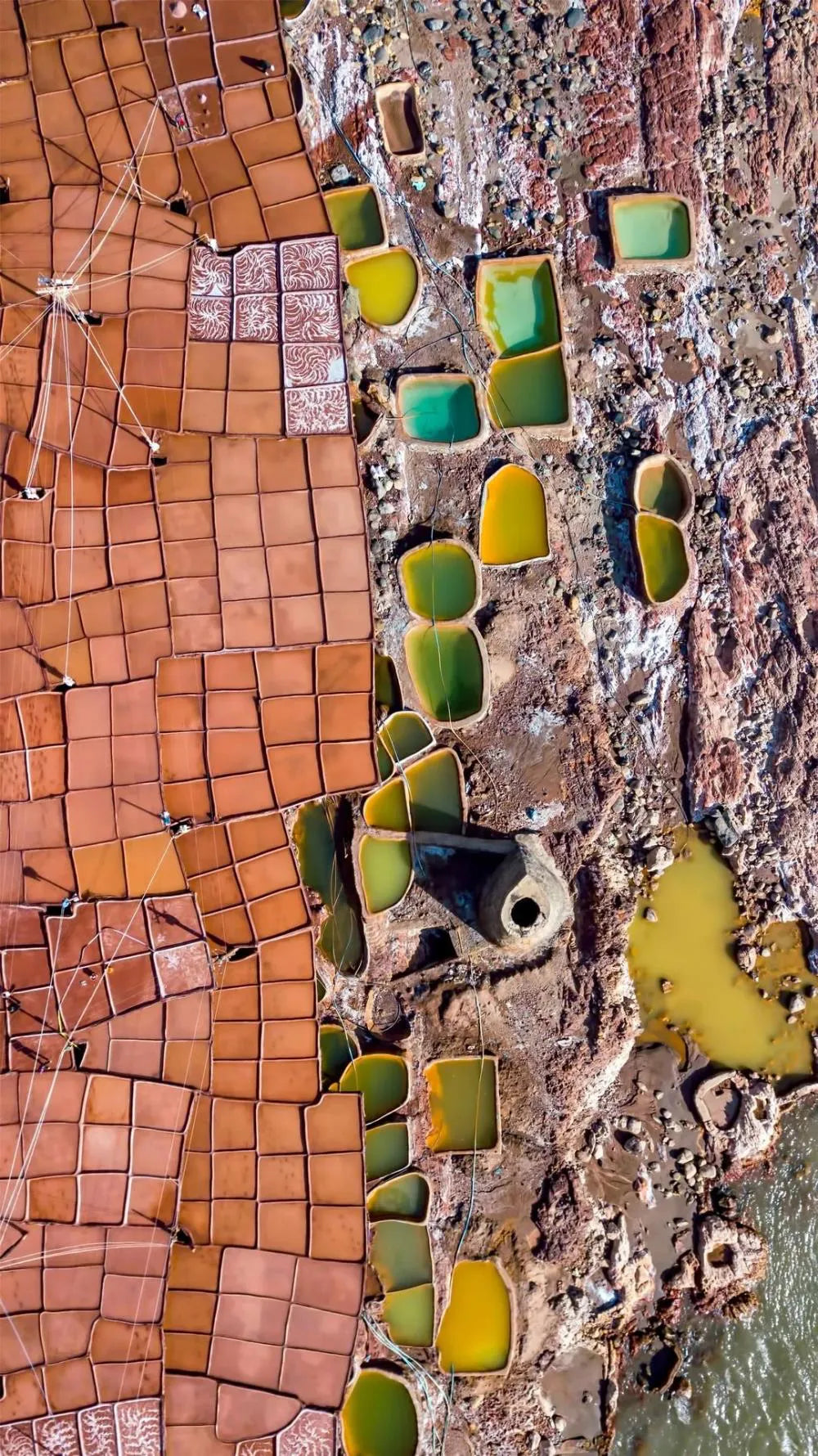
"The eyeshadow palette of nature" ▎Salt flats of Mangkang in Tibet

Like a natural eyeshadow palette, the Mangkang salt flats.

Photographer: Lin Haiyin


Photographed by Zhang Mingfang

Photo source: Youth Changdu
The history of salt
Seven things to open the door: "firewood, rice, oil, salt, sauce, vinegar, and tea", among which salt is the magical ingredient that can change the taste buds of all of us. The great literary scholar Su Shi of the Song Dynasty once wrote in his poetry, "How can we forget the taste of the feast, since there has been no salt in our food for three months." Without salt when eating, even if the food is expensive, scarce, or originally delicious, it will taste like wax. It is because of the presence of salt that food has a soul and becomes fragrant. Salt is not only an important seasoning, but also an essential substance for maintaining normal growth and development in the human body. However, consuming too much salt is harmful and not beneficial to the body.




The formation and legends of the thousand-year-old ancient salt field.
(1)
Approximately 40,000 years ago, the Himalayas and the Tibetan Plateau were covered by a vast ocean. Later, due to the collision and compression of the Indian Ocean plate and the Asian plate, the land beneath the sea slowly rose up, gradually forming the plateau and mountains that we see today.
Generally speaking, the boundary where the Indian Ocean plate collides with the Asian plate is a subduction boundary, which is the zone where trenches and mountains are formed. As a result, seawater is continuously lifted up with the movement of the crust to form underground lakes on land, and this is the main reason for the presence of salt in this area.

Diagram of the six major sectors disappearing and growing boundaries.
Furthermore, according to a paper published online by the School of Resources and Environment at Lanzhou University, the research team led by Nie Junsheng found that the upper, middle, and lower reaches of the Lancang River experienced significant rapid incision around 17 million years ago, leading to the formation of the Lancang River.
The plateau climate has also become increasingly dry, causing the plateau lakes to evaporate and accumulate salt, forming a salt crust buried underground. When the rock layers near the Lancang River fractured, underground hot springs dissolved the salt crust and emerged on the surface, forming the salt wells seen today.


Here has always retained the oldest and most primitive method of salt production. For thousands of years, there have been numerous wars fought here to control the ownership of salt wells, and the people here have been enslaved for a long time in history. It was only a few decades ago that the people here began to have their own salt fields thanks to China's reform and opening up.

Image source: Mangkang Tourism


Salt Flats and the Salt Woman
The salt fields of Mangkang are very special, standing tall by the Lancang River, resembling a makeup palette created by nature. The salt-making process is not complicated, and the salt fields are built by the local residents themselves. They first use large wooden stakes to build the framework, then lay wooden planks on top, followed by a layer of sand and gravel, compacting it tightly. Brine is then poured in, allowing it to evaporate upwards and penetrate downwards, making it very practical. Local residents then dig deep salt wells by the river, and bring in river water to dissolve the ancient salt layers, forming brine. The brine is extracted and dried, then processed by the local "salt women" to form salt.

Here, even the salt extracted from the same river in the same village varies. The main reason for this is the different soil quality and geographical location on either side of the river. Salt Well Village and Naxi Village are located on the east bank of the Lancang River. Due to the steep terrain, the salt fields built here are narrow, resulting in salt that cannot be formed into blocks. However, the salt produced here is snow-white, with few impurities, and of high quality. This type of salt is also known as "snowflake salt," and it is the highest quality salt produced in Salt Well Village.
 Mangkang Snowflake Salt
Mangkang Snowflake Salt


Image source: Changdu City Tourism Development Bureau official website

The "salt women" here believe that salt is a precious treasure given to them by the wind and sunlight for their survival, unaware that the most valuable wealth in the area is the salt-making skills inherited from their ancestors and their hard work in the salt fields. The ancient and primitive method of making salt is being passed down by generations of "salt women" like themselves, who continue this tradition with their lives and beliefs.

Image source: Personal illustration
The intergenerational connection between Jada Village and Gera Village
Gera Village is a small village surrounded by seven peaks over 6000 meters high, and the villagers here have always relied on livestock farming for their livelihood. When milking in the morning, the herdsmen attract yaks and sheep together with a mysterious substance, which is the red salt produced by the salt well. Animals need much more salt than humans, so salt is an essential resource for the herdsmen.

The yaks in Gela Village must eat the red salt from Gada Village, as this salt can help yaks gain weight, reproduce, and prevent diseases. This is why Gela Village has been using salt from Gada Village for generations. The herdsmen in Gela Village will use yak milk to make butter, with only a small portion kept for their own consumption, while the rest will be taken out by men to exchange for money or goods. Twice a year, the herdsmen will drive hundreds of yaks to Gada Village to exchange for salt and grains, following our traditional barter system.



The second Temple of Princess Wencheng in Tibetan-inhabited region
In addition to the Princess Wencheng Temple in the Benagu Valley southeast of Jiegu Town, Yushu City, Yushu Tibetan Autonomous Prefecture, Tibet also has a Princess Wencheng Temple in the Zaguxi Gorge of Juolong Village, Naxi Township, Mangkang County, Chamdo City. According to local staff, before the construction of the Princess Wencheng Temple, many rocks slid down from the mountain slope and people found this magical large rock when clearing the rocks. So later, the Princess Wencheng Temple was built on this large rock.

Princess Wencheng Temple in Chamdo, Tibet
Photographed by Li Yuanmei
Now the temple inside the Princess Wencheng Temple is not very large, with a large rock in the center of the temple, mainly dedicated to several vivid "deities" on the rock, including the natural statue of Tibetan King Songtsen Gampo and Tang Dynasty Princess Wencheng. It is said that the "deities" on this large rock are not artificially carved, but naturally formed, which is truly admirable for the amazing work of nature. Local Tibetans believe that this large rock has divine aura and come to worship it.

The only Catholic church in Tibet
The Salt Well Catholic Church is an exemplary case of the exchange and fusion of Chinese Tibetan culture and Western culture, and it is also a rare example of religious and cultural exchange in the history of Chinese Buddhism and Tibetan Buddhism. The process of building the Catholic church in Yanjing was described by Mu Yongwen in his article "The Catholic Church on the Roof of the World" published in the Tibet Daily, stating that "in Tibet, where almost all the people believe in Buddhism, the story of Catholicism taking root in this Buddhist holy land of the Tibetan plateau is filled with miracles and melancholy."

Image source: Chamdo Tourism
In 1865, a French missionary named Dingyi crossed the river from Batang, Sichuan to Mangkang, Tibet. At that time, the local ruler of Tibet, where religion and politics were combined, refused to let him preach in Mangkang and drove him away from the Weisigou Monastery to Yanjing. Dingyi first preached in the ancient Guge Kingdom in Ali, and later went to Shigatse and Lhasa. Subsequently, there were religious unrest in Tibet and Qinghai, and the priest was expelled.
Dingyi narrowly escaped death and took another route from abroad to Longjiang, Yunnan, and then to Yanjing in Tibet. This time he learned his lesson and, upon arrival, first gave gifts to the local leader Dabagong Gangdazha, before finally purchasing a piece of land. Although Dingyi had the permission to preach from the local government in Yunnan, the Gaxia local government in Tibet still did not allow him to preach in Yanjing. Dingyi could only wait for an opportunity in Yanjing.

Photographed by Liu Xiaoshun

Photographed by Liu Xiaoshun
Throughout history, the development of Catholicism in Tibet has not been smooth sailing. In the sacred Buddhist land, the situation for non-Buddhists has been quite difficult. In 1905, there was a religious uprising in which more than 10 Catholics lost their lives, and in 1949, Swiss priest Father Du Zhongxian was beaten to death.
In addition to this account, there are also some folk beliefs. In 1878, a French missionary named Father Blanc introduced Catholicism to Tibet. In 1880, he met with Father Petit, who was already conducting missionary work in Batang, and in 1887, he was expelled from Batang and had to return to Yanjing before constructing the Catholic church there. In 1991, Liu Jun published a paper titled "Analysis of Foreign Churches in Kang Region" in "Tibet Studies," stating that the Yanjing church was founded by French missionary Priest Lü Siduo in the 1860s with 342 believers.
There are many differing accounts of the founding of the Catholic church in Yanjing, Tibet, and there is currently no unified conclusion.

Photographed by Liu Xiaoshun

Image source: Master's thesis by Yu Lanying
The missionaries here are dressed in Tibetan clothing, and the believers use the only Tibetan version of the Bible in the world. The exterior of the church is also in the architectural style of Tibetan houses, and even the offerings made in front of the statue of the Virgin Mary are traditional Tibetan scarves. The young Naxi people here wear Tibetan clothes, speak Tibetan, and have largely adopted Tibetan way of life, living as Tibetans in Naxi identity.

Image source: Master's thesis by Yu Lanying
At the same time, the Catholics here also follow local customs. Although they celebrate Christmas as a major holiday, they also view the Tibetan New Year as the beginning of the new year like their Tibetan compatriots. When celebrating Christmas, in addition to the priest conducting Mass and preaching, there are also Tibetan traditional Guozhuang dance and string dance to celebrate, which can be considered as a cultural fusion.


